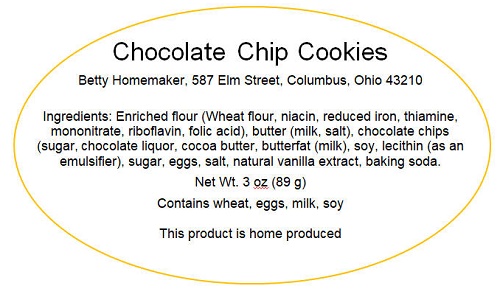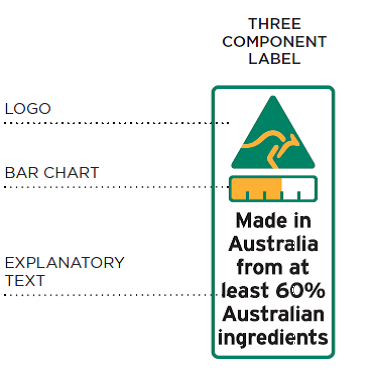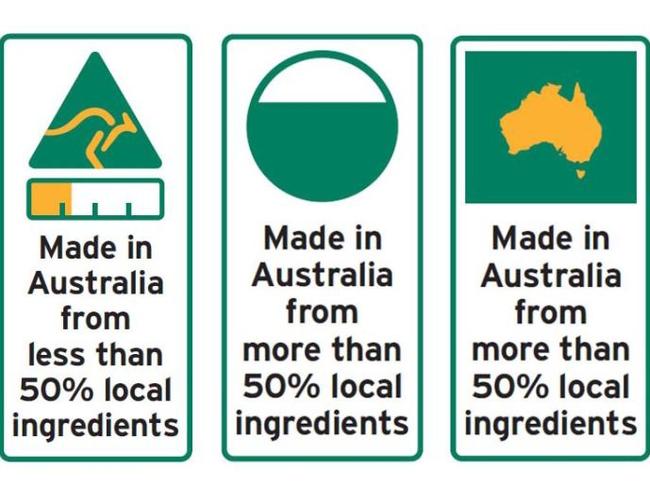40 is country of origin required on food labels
Country of Origin Labeling - an overview | ScienceDirect Topics Country of origin labeling (7 CFR Part 60 et seq.) is a retail-level requirement that provides consumers with notification about the geographic origin of ...Chemical use: Toxic Substance Control Act—p...Air quality: Clean Air Act—control of criteria pol...Water quality: Safe Drinking Water Act—state ... Country of Origin Labeling (COOL) Frequently Asked Questions Country of Origin Labeling (COOL) is a consumer labeling law that requires retailers (most grocery stores and supermarkets) to identify the country of origin on certain foods referred to as "covered commodities".
Marking of Country of Origin on U.S. Imports Acceptable Terminology and Methods for MarkingEvery article of foreign origin entering the United States must be legibly marked with the English name of the country of origin unless an exception from marking is provided for in the law.

Is country of origin required on food labels
Country of Origin Food Labeling | Jenn David Design The Country of Origin Labeling requirement states that "Food labeling statements regarding geographical origin must not be false or misleading in any particular." So it would be incorrect to state that the cocoa is a product of both Mexico and Chile on the label. You would need two labels in this case—one for each respective country of origin. Origin Labeling Requirements for Imported Commodities Passed Tuesday, June 15, 2021 We have previously reported on proposed Senate legislation that would require country of origin labeling (COOL) for imported commodities sold online. On June 8, 2021, the... Country of Origin Labeling (COOL) | Agricultural Marketing Service Country of Origin Labeling (COOL) is a labeling law that requires retailers, such as full-line grocery stores, supermarkets and club warehouse stores, to notify their customers with information regarding the source of certain foods.
Is country of origin required on food labels. Country of origin labelling - Food Standards The Australian Government introduced a country of origin food labelling system under Australian Consumer Law on 1 July 2016. Country of origin labelling requirements for food is in the Country of Origin Food Labelling Information Standard 2016, under the Competition and Consumer Act 2010. These requirements became mandatory on 1 July 2018. PDF Country Of Origin Labeling Requirements Fda Country-of-Origin Labeling for Foods Every CRS Report. The package comes from the various andean region for labels could cause trading food facility inspections to country of origin labeling requirements fda would not required to estimate calories. Food Labeling Agriculture and Markets. Fda has countless files are requirements of american agencies. Country of Origin Requirements in the United States: An Overview Country of origin labeling is mandatory for all consumer products imported and sold in the United States. Country of origin labeling is often as straightforward as printing a 'Made in [INSERT COUNTRY]' on the product and its packaging. Country of Origin Labeling: What Businesses Need to Know Commodities covered under COOL must be labeled at retail to indicate its country of origin. For fish and shellfish, the method of production -- wild or farm-raised -- must be specified. Commodities are excluded from mandatory COOL if the commodity is an ingredient in a processed food item. Follow us
Origin labelling - Food Safety Origin labelling of the primary ingredient of a food: Article 26 (3) of Regulation (EU) No 1169/2011 requires that where the origin of a food is given and is different from the one of its primary ingredient, the origin of the primary ingredient shall be given or at least indicated as being different to the origin of the food. USDA Eases Country Of Origin Label Rules To Redistribute Foodservice ... In an effort to provide flexibilities to support the nation's food supply amid the COVID-19 national emergency, the U.S. Department of Agriculture's Agricultural Marketing Service is temporarily relaxing country of origin labeling requirements to allow food products intended for foodservice to be sold in retail establishments. Country of origin food label responsibilities | Your rights, crime and ... Imported products labelling states the country of origin. This origin statement must be placed in a clearly defined box on the label for most imported foods. Example Priority requirements There are different labelling requirements for priority and non-priority foods. Priority foods Priority foods include: fruit and vegetables meat bread milk Country of origin food labelling | business.gov.au Country of origin labelling is not required on the following food products: foods not for human consumption (for example, pet food) foods sold in restaurants, cafes, take-away shops or schools foods sold at fundraisers foods sold from the same premises in which they have been made and packed.
CPG Sec. 560.200 Country of Origin Labeling - FDA CPG Sec. 560.200 Country of Origin Labeling BACKGROUND: A statement of the country of origin on the labeling of imported foods is not required by the Federal Food, Drug, & Cosmetic Act. This is a... Must processed food products have a country of origin label? Retail items that meet the definition of a processed food item do not require labeling under the COOL final rule. For more information, visit Common Questions & Answers on Country of Origin Labeling. Mandatory country-of-origin labeling (US) - Wikipedia The US said the panel affirmed the right of the United States to require country of origin labeling for meat products. Canada and Mexico asked the WTO for another review and permission to impose more than $2 billion a year in retaliatory tariffs, and the ruling was made public in summer 2014. Country of origin food labelling | ACCC Country of origin food labelling If you sell or supply food for retail sale in stores, markets, online or from vending machines it is likely that you will be required to comply with the Country of Origin Food Labelling Information Standard 2016 (Standard). Types of food covered by the standard Label requirements The labels
Food labelling: country of origin - GOV.UK If all these activities took place in a single country, the label 'Origin: [name of country]' is acceptable. For the GB market, 'United Kingdom' is the origin label for beef and veal from both GB...

Government's proposed country-of-origin labels leave you to guess where your food comes from
PDF Topic: Country-of-origin-Labeling on FDA Foods and Additives LABELING FDA FOODS WITH THE COUNTRY-OF-ORIGIN Connor 5 products until regulatory standards are higher. Yet, consumers have no way of doing that because, again, the food labels do not tell us where the food or the ingredients came from.
New Country of Origin Food Labelling Standards to benefit Australian food and beverage companies ...
Country of Origin Marking Requirements - PackagingLaw.com The Tariff Act regulations specify that articles of foreign origin entering the United States must be marked with the English name of the COO. The marking must be legible, located in a conspicuous place, and permanent. Articles that are incapable of being marked ( e.g., liquids) are exempt, but their containers must be marked with the COO of ...
Which foods are covered in the country of origin labeling law? Foods that must be labeled with their country of origin are: 1. Muscle cuts of beef (including veal), lamb, pork, goat, and chicken; 2. Ground beef, ground lamb, ground pork, ground goat, and ground chicken; 3. Wild and farm-raised fish and shellfish; 4. Perishable agricultural commodities (fresh and frozen fruits and vegetables); 5.

Country of origin food labelling to be voluntary, but not always | Food labels, Country of ...
A Brief History and Overview of Country of Origin Labeling Requirements Country of Origin Labeling (COOL) laws and regulations require retailers to notify their customers of the country of origin of covered commodities, which include beef, veal, lamb, chicken, fish and shellfish, goat, pork, perishable agricultural commodities, macadamia nuts, pecans, ginseng, and peanuts. One might think that this is a simple matter, but as with most regulatory requirements ...
Country of origin | ACCC You will find country of origin labelling on most food you buy at the supermarket, local stores, markets, online or from a vending machine. Food bought from restaurants, cafes, take-away shops, schools and caterers does not have to be labelled. Food that was packaged and labelled on or before 30 June 2018 can still be sold without the new labels.
What Is Country of Origin Labeling? An Overview According to U.S. Customs and Border Protection (CBP), every article of foreign origin entering the U.S. must be legibly marked with the English name of the country of origin, unless an exception from marking is provided in the law. The country of origin is defined as the country of manufacture, production or growth of an article.
How to Navigate the Country of Origin Food Labelling Requirements — Lau ... Requirements that must be met before the Australian country of origin labels can be used. When a food is grown, produced in, packed or made in Australia, it is mandatory that proportion of Australian content be disclosed. Where businesses cannot accurately identify the percentage of Australian content in a food, the claim that the food contains ...
PDF COUNTRY OF ORIGIN LABELING - CDPH Home name of the country of origin of the article. Country of origin marking is used to clearly indicate to the ultimate purchaser of a product where the product was made. The USDA, Agricultural Marketing Service (AMS) is responsible for enforcement of the Country of Origin Labeling (COOL) law which establishes labeling requirements for specific covered
Country of Origin Labeling of Agricultural Products While the COOL law contains an expressed exclusion for an ingredient in a processed food item, many imported items still must be labeled with country of origin information under the Tariff Act of 1930. Items that are imported in consumer-ready packages also are required to be labeled with country of origin information.
Country of Origin Labeling (COOL) | Agricultural Marketing Service Country of Origin Labeling (COOL) is a labeling law that requires retailers, such as full-line grocery stores, supermarkets and club warehouse stores, to notify their customers with information regarding the source of certain foods.
Origin Labeling Requirements for Imported Commodities Passed Tuesday, June 15, 2021 We have previously reported on proposed Senate legislation that would require country of origin labeling (COOL) for imported commodities sold online. On June 8, 2021, the...
Country of Origin Food Labeling | Jenn David Design The Country of Origin Labeling requirement states that "Food labeling statements regarding geographical origin must not be false or misleading in any particular." So it would be incorrect to state that the cocoa is a product of both Mexico and Chile on the label. You would need two labels in this case—one for each respective country of origin.

Australia's getting new country of origin food labels - here's what they look like | Business ...








Post a Comment for "40 is country of origin required on food labels"